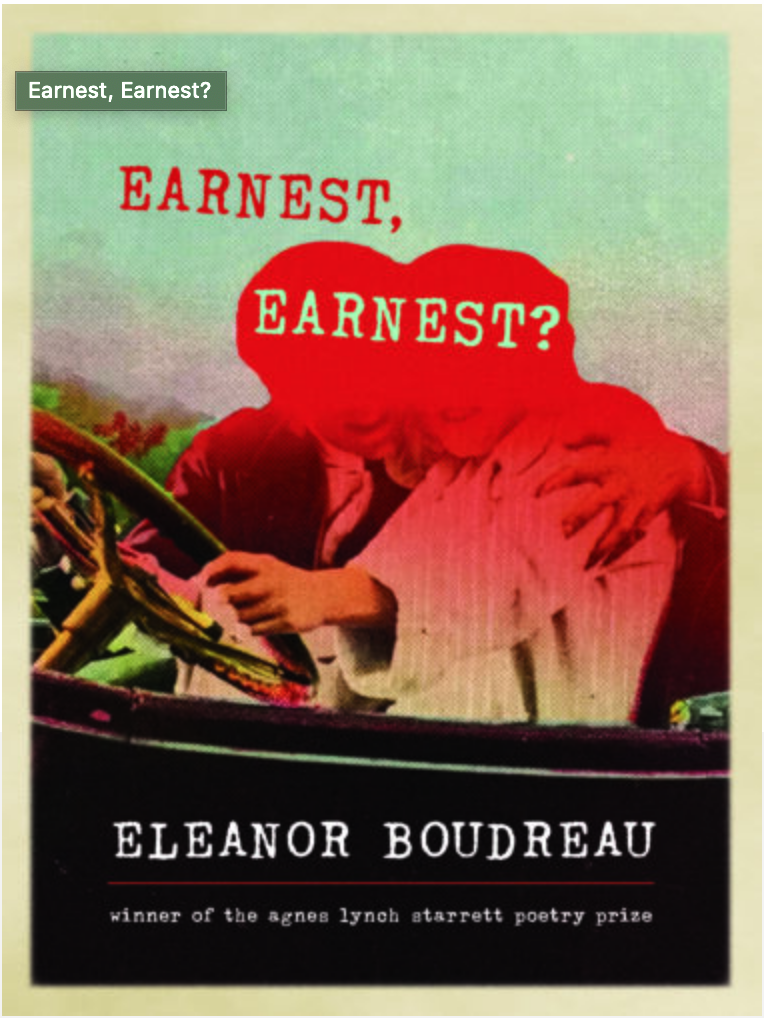How It’s Made: Eleanor Boudreau’s Earnest, Earnest?

We’re so happy to have had the chance to look under the hood of Eleanor Boudreau’s bold debut, Earnest, Earnest? (from University of Pittsburg Press). “What a witty, glorious, and bittersweet book,” DA Powell says, “I am here for all of it.” With our How It’s Made series, we endeavor to take away some of that ever-present mystery of how a collection like this one comes to being.
What were the most joyful moments of Earnest, Earnest?’s journey to publication?
In Earnest, Earnest?, the speaker, Eleanor, writes postcards to her on-again-off-again lover, Earnest. The fact that her lover’s name is Earnest and that their relationship is fraught, raises questions of sincerity and irony, and whether both can be present at the same time. While Earnest can be read literally as Eleanor’s lover, he is best understood as another side of the poet’s self. The ambiguity at play in Earnest, Earnest? is embodied in the text/image form of the “Earnest Postcards” that structure the book. Each “Earnest Postcard” is two pages and consists of the front of the postcard (an image) and the back (Eleanor’s message to Earnest). The “Earnest Postcards” are experimental in their use of images and formal in their dialogue with the sonnet. Like the sonnet, these poems have two parts, include a turn, and are all very close to fourteen lines. The first “Earnest Postcard” is exactly fourteen lines (split across front and back) and ends on a rhyming couplet of iambic pentameter:
What else can I tell you? What else is true?
The child I did not have belonged to you.
It is difficult to choose whether this “Earnest Postcard” is a sonnet or not, just as it is difficult to choose whether Eleanor’s address of Earnest is sincere or not. Thus, Earnest, Earnest? is a question of tone, address, and form.
The “Earnest Postcards” are integral to my book and compelling in the ways form and content work in concert, (at least they seem compelling to me). But I had a difficult time getting them published. I want to blame the images, but perhaps it is more complicated—the images made these poems more experimental than most formal poetry, the dialogue with the sonnet made them more formal than most experimental poetry. Or perhaps it is simple—readers just didn’t like them.
Finally, Camille Dungy published one of my “Earnest Postcards” in Tin House. I had admired the way Dungy reinvigorated the sonnet in What to Eat, What to Drink, What to Leave for Poison, and I believed I had learned from it. Having her respond to one of my “Earnest Postcards” will always be one of the most joyful moments of my career.
What were the toughest moments you faced while getting the collection to the world and what have you taken away from them?
Shortly before I finished Earnest, Earnest?, my appendix burst and I found myself suddenly in a life-threatening situation. Once the organ is in tiny pieces, this can lead to infection, sepsis, and death. I didn’t, however, know I was in mortal danger. All I knew was I was in excruciating pain.
I wound up in this dire circumstance because I hadn’t felt any pain at what I now believe was the initial rupture, almost three weeks before. At that time, I felt what I can only describe as a slight static in my abdomen. And it went away in a day or two. From there, however, I witnessed the shutdown of my bodily functions—first my menstruation, then my bowels, then my ability to regulate my temperature. I’d start shivering while teaching Hamlet, so I’d put on one sweater, then another. Then I’d start sweating profusely, so I’d take the sweaters off. Still, I wasn’t in any pain. I ran four or five miles a day, I played tennis.
But when the tissue finally burst, that was agony. I couldn’t sleep, I couldn’t eat, I couldn’t not wail. Still, I held off on going to the hospital because I was afraid of how much it would cost.
When a surgeon finally opened me up, approximately 40 hours after the burst, he saw the fragments of my appendix. The procedure then became about removing the debris and it took much longer than expected.
Afterwards, I got the impression the surgeon was mad at me. It was a mess in there, he said, pointing at my abdomen. I just looked at him. If poetry has taught me anything it’s that life is messy, pain is messy. What did he expect my insides to be like?
The recovery from this surgery took months. And those months were miserable and desperate. I had been working on my manuscript for almost 15 years and I still didn’t have a book contract. I also didn’t have any financial stability—to the contrary, I was making the least amount of money I had ever made (already a low bar) and I had hospital bills I could not pay. I was weak, I was utterly exhausted, and sometimes I was in severe pain. I finished Earnest, Earnest? during this period, but it hurt me. Even now, I don’t think I’m “over it.” I think about it daily.
There’s a line in Earnest, Earnest?: “You don’t seem to feel pain, Eleanor.” This line is drawn from my life, not in the sense that it is a direct quote, but in so far as, over the years, people have told me that they feel my response to pain—both psychological and physical—is off and dull. That I show less pain than I should feel. The people who say this are usually men. I never thought these men were right. I just assumed they were wimps.
But after having ended up in a life-threatening situation because I didn’t feel pain at the onset of the problem (a time when most people do feel a great deal of pain), I take this line more seriously. I have moved it from the category of Complete Untruth to Exaggeration Based on Truth.
I am not saying that everything in my book is true. In Earnest, Earnest?, I did not invent images—all the images are things I have seen—but I did invent narratives to fit the images. I believe this is my right as a poet.
Yet even as I made things up, my poems wound up knowing things I didn’t know. Or didn’t believe. That is a reason to keep writing poetry.
What did you learn about writing and poetry over the journey of this book?
While I was working on Earnest, Earnest?, I got two pieces of advice:
- Every book of poetry needs to have an ars poetica that tells readers how to read the book.
- If you can’t say in a few sentences what a book is about, then it’s not a book.
I thought both were crap. I thought poetry was a wild thing and didn’t need an instruction manual or an elevator pitch. But while I was recovering from major surgery, I finished the ars poetica for Earnest, Earnest? and inserted it into the manuscript. “If Tony Hoagland Was Right” was the last addition before I submitted my book to the Agnes Lynch Starrett Poetry Prize, the prize it eventually won.
I didn’t send a description of my book to the Starrett Prize. I included a brief bio in the “Cover Letter” field in Submittable, but I didn’t make any attempt to explain what held the book together. At the time, I couldn’t articulate it.
But just a few weeks before Ed Ochester emailed me to tell me that my manuscript had won the Starrett Prize, I wrote the five-sentence description that you can now read if you are looking at Earnest, Earnest? on IndieBound, Bookshop, or Amazon.
I now think the advice I got was right on the money. Every book needs an ars poetica and a brief-but-compelling description.
What’s your one sentence piece of advice for poets currently putting a collection together?
Ask yourself, Do I want to live in a world where “X Poem” isn’t considered poetry?, and if the answer is no, don’t cut the poem, keep working on it, no matter what.
 Eleanor Boudreau is a poet who has worked as a dry-cleaner and as a radio reporter. Her poems have appeared in American Poetry Review, Tin House, Barrow Street, Waxwing, Willow Springs, FIELD, Copper Nickel, and other journals. Currently, she is finishing her PhD and teaching creative writing at Florida State University.
Eleanor Boudreau is a poet who has worked as a dry-cleaner and as a radio reporter. Her poems have appeared in American Poetry Review, Tin House, Barrow Street, Waxwing, Willow Springs, FIELD, Copper Nickel, and other journals. Currently, she is finishing her PhD and teaching creative writing at Florida State University.
You can find their collection here.